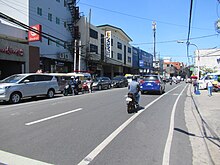 R-6 C-1  | |
|---|---|
 Legarda Street eastbound in Sampaloc | |
 The route of Legarda Street in
Metro Manila. Legarda Street is highlighted in red. | |
| Former name(s) | Calle Alix Plaza Santa Ana Calle Concordia |
| Part of | |
| Namesake |
Benito Legarda José María Alix y Bonache (formerly) |
| Length | 1.4 km (0.87 mi) |
| Location | Manila |
| East end | |
| Major junctions | |
| West end | |
Legarda Street is a short street located in Sampaloc district in Manila, Philippines. It crosses through the eastern section of the University Belt area in a generally east–west orientation between the Nagtahan Interchange and the intersection with Nepomuceno Street in Quiapo. It is served by Legarda station of the LRTA's Line 2 system.
The street was named after Filipino legislator and resident commissioner to the United States, Benito Legarda y Tuason. [1] Historically, its section in Sampaloc was formerly called Calle Alix (after a Real Audiencia of Manila magistrate of the 1860s, José María Alix y Bonache), [2] [3] while its section in Quiapo was formerly called Plaza Santa Ana and Calle Concordia, respectively. [4] [5] [6]
Route

Legarda Street commences at the Nagtahan Interchange as a westward continuation of Magsaysay Boulevard from Santa Mesa. It heads due west, traversing the southern edge of Sampaloc and skirting the northern boundary of San Miguel. After crossing Figueras Street, Legarda bends to the southwest following the course of Estero de San Miguel (San Miguel Creek). It intersects with Recto Avenue– Mendiola Street, wherein the majority of its traffic turn towards Recto Avenue serving as a major continuation westward, and San Rafael Street before terminating and briefly converging with the junction at Nepomuceno Street (formerly Tanduay Street) in Quiapo before it is continued by P. Casal Street towards San Miguel and Ayala Bridge to Ermita on the southern bank of the Pasig River.
Notable establishments on Legarda Street include Arellano University, Santa Catalina College, the main campus of ABE International Business College, San Lorenzo Ruiz Student Catholic Center, Mendiola Theater and the Department of Social Welfare and Development– NCR Office.
History
On May 1, 2001, Legarda Street was the site of riots initiated by pro-Estrada protesters being pushed back from Malacañang Palace by police authorities during EDSA III. [7]
Intersections
The entire route is located in Manila.
| km [8] | mi | Destinations | Notes | ||
|---|---|---|---|---|---|
| Western terminus. | |||||
| Cruzada Street | Eastbound only | ||||
| San Rafael Street | Unsignalized intersection | ||||
| Traffic light intersection. No left turn from westbound; transition from C-1 to R-6 | |||||
| F. Dalupan Street (Gastambide Street) | Westbound only | ||||
| M. V. Delos Santos Street | Westbound only | ||||
| D. Santiago Street | Westbound only | ||||
| Delgado Street | Westbound only | ||||
| Main Street | Westbound only | ||||
| Legarda Station Access Road (entrance) | Eastbound only; access to Legarda station | ||||
| J. Figueras Street | Traffic light intersection | ||||
| Manrique Street | Westbound only | ||||
| Legarda Station Access Road (exit) | Eastbound only | ||||
| M.F. Jhocson Street | Westbound only | ||||
| West end of Legarda Flyover | |||||
| Sta. Teresita Street | Westbound only | ||||
| 4.205 | 2.613 |
Nagtahan Interchange. Eastern terminus; traffic light intersection. Continues eastward as | |||
1.000 mi = 1.609 km; 1.000 km = 0.621 mi
| |||||
Landmarks
From west to east:
- Santa Catalina College
- Arellano University
- ABE International Business College
- University of Manila
- San Sebastian College – Recoletos
- San Sebastian Church (Manila)
- National Teachers College
- Technological Institute of the Philippines
See also
References
- ^ "Did you know? Legarda Street". Philippine Daily Inquirer. September 27, 2013. Retrieved November 1, 2013.
- ^ "Legarda Street". Historiles.com. Retrieved November 1, 2013.
- ^ "Full text of "Guía oficiál de España"". Archive.org. 1874. Retrieved November 1, 2013.
- ^ de Gamoneda, Francisco J. (1898). Plano de Manila y sus Arrables [Map of Manila and its suburbs] (Map). 1:10,000 (in Spanish). Retrieved March 22, 2022.
- ^ Malcolm, George (1917). The Charter of the City of Manila, with which are Printed Such Further Portions of the Administrative Code and Other Laws as Mention and Directly Concern the Government of the City, and the Revised Ordinances ... Together with Certain Special Ordinances ... All Annotated with Decisions of the Supreme Court of the United States and of the Philippines. Manila, Philippines: Manila Bureau of Printing. p. 489.
- ^ Map of the City of Manila and vicinity (Map). United States. War Department. General Staff. 1907. Retrieved March 27, 2022.
-
^ Frialde, Mike; Etolle, Nestor (May 2, 2001).
"4 killed as Estrada supporters assault Palace".
Philstar.com. Philstar Global Corp. Retrieved March 25, 2024.
The mob also set a back hoe at the corner of Mendiola and Legarda streets on fire and threw rocks at the dispersal team which separated into two teams and continued to pursue the loyalists down Claro M. Recto Avenue.
- ^ "North Manila". 2016 DPWH data. Department of Public Works and Highways. Archived from the original on August 13, 2017. Retrieved August 13, 2017.